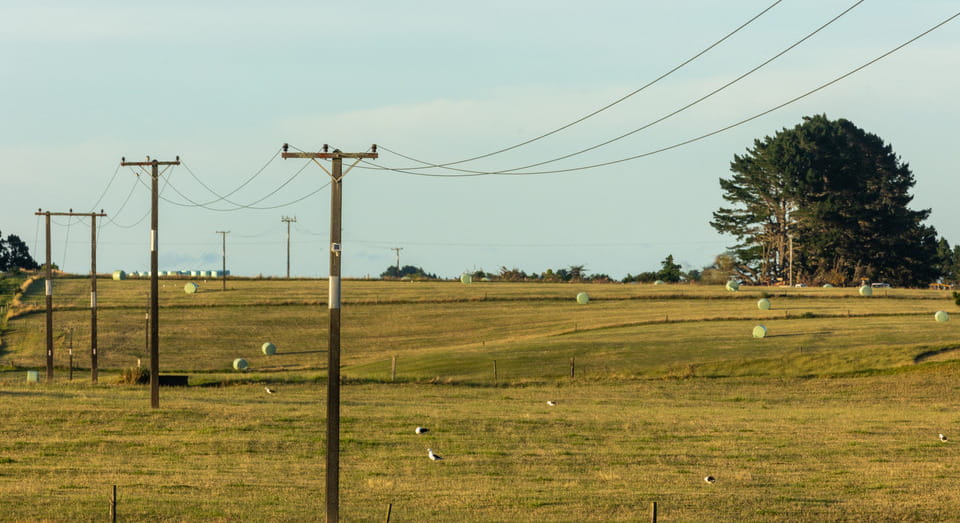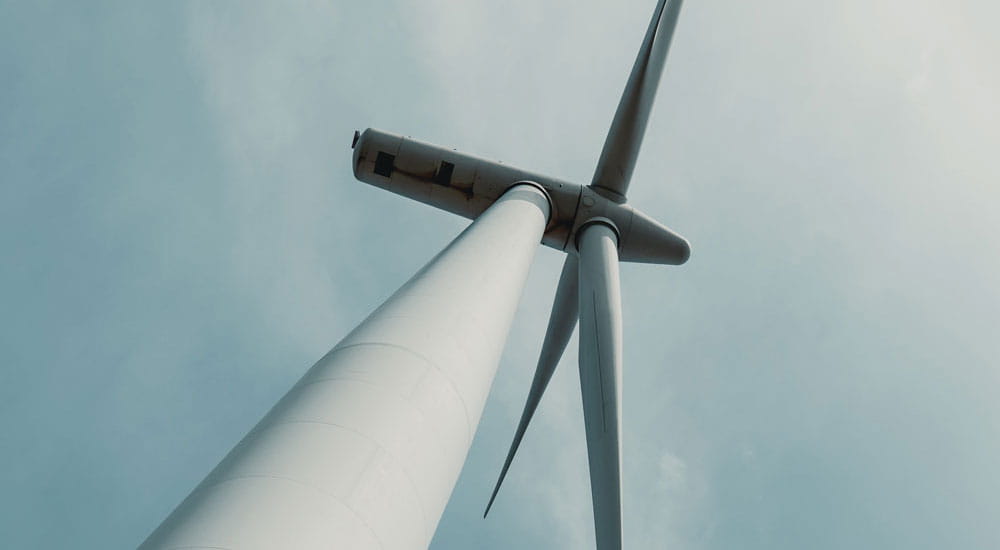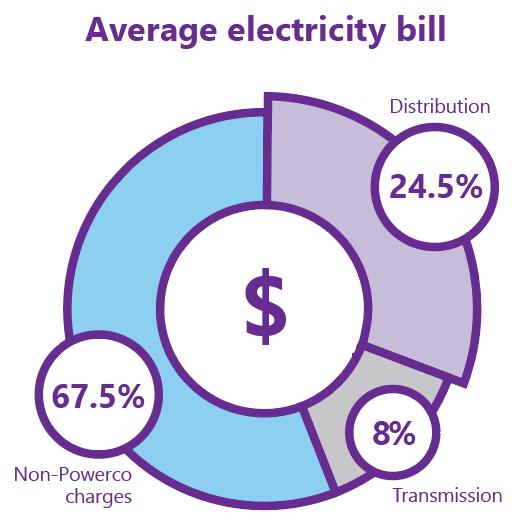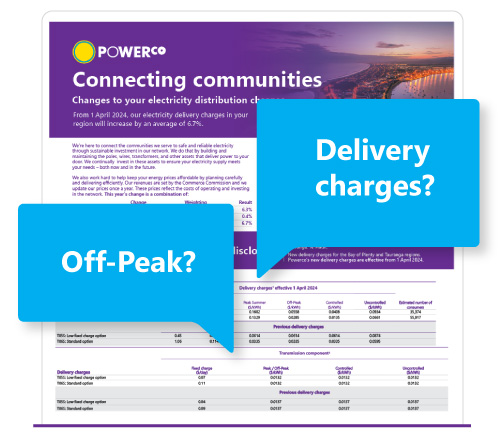Electricity pricing
We’re one part of your electricity bill
We own and maintain over 29,200km of local lines, cables, substations and other assets that deliver electricity to over 900,000 Kiwis across the North Island.
We bring the electricity to your door, and this part of the supply chain is called ‘distribution’.
The electricity bill you get from your retailer is made up of a number of charges:
- Distribution
This covers our costs to invest in and maintain our network to ensure we provide safe and reliable electricity to your door now and in the future.
- Transmission
This covers Transpower’s costs of getting electricity from the power stations where it’s generated to our network via the national grid. Transpower charges us, and we pass this on to you.
- Generation, retail and other charges
This covers the costs of generating the electricity at the power station, your retailer’s costs, GST and levvies. This is also where you pay for the electricity that you use, as measured by your power meter reading.
We update our prices each year to ensure we can continue to meet electricity demand as the communities we serve continue to growth, and the way our customers use electricity changes.
Our new pricing is effective from 1 April each year.
The overall impact on your electricity bill will depend on things like how and when you use electricity and how your retailer chooses to pass our charges on to you.
Our prices from 1 April 2025
Our charges differ depending on the region you live in. This reflects things like the varying levels of investment needed, and the number of customers we serve in that area.
Click on the map to find the prices for your region.
Our prices are regulated to ensure they’re fair
We’re regulated by the Commerce Commission to ensure we provide reliable electricity supply at a fair price to you.
As part of this, the Commerce Commission sets the amount of revenue we get from our customers in the form of charges once every five years.
The latest reset determines our revenue for 1 April 2025 – 31 March 2030.
The last time our revenue was reset was in 2019.
Since 2019 factors like inflation, interest rates and rising prices have all contributed to higher costs. Customer demand for electricity is also growing - as customers switch away from fossil fuels and towards EVs for instance. That means we need more investment to meet demand.
That’s why the Commerce Commission has allowed lines companies to increase their revenue in the latest reset. (The total revenue increase will be made gradually over the next five years, through our annual price changes).
You can find out more about the Commission’s decision on its website.
Increase in low-fixed user charges for residential customers
This year we’re continuing to phase out low-fixed charges in line with the removal of low-fixed charge regulations.
That means your low-fixed charge (if you’re on one) will go up, as we progressively bring it into line with standard daily fixed charges over the five years ending 2027.
Once complete, all of our residential customers will have the same daily fixed charge. That daily fixed charge rate depends on the region you live in. You can find your daily fixed charge rate in our pricing tables below.
To find out whether you are on a low-fixed charge you’ll need to contact your retailer (the company you pay your power bill to).
Find out more about why low-fixed charges are being phased out.
Our pricing tables explained
Click here for more information about how to understand our pricing tables.
More information on how we calculate our pricing is available in our pricing methodology document further down this page.
Prices for Taranaki, Whanganui, Manawatū, Rangitīkei and Wairarapa
Prices for Coromandel, Thames and South Waikato
Coromandel, Thames and South Waikato pricing 1 April 2025 – 31 March 2026Coromandel, Thames and South Waikato pricing 1 April 2024 - 31 March 2025
Coromandel, Thames and South Waikato pricing 1 April 2023 – 31 March 2024
Coromandel, Thames and South Waikato pricing 1 April 2022 – 31 March 2023
Coromandel, Thames and South Waikato pricing 1 April 2021 – 31 March 2022
Coromandel, Thames and South Waikato pricing 1 April 2020 – 31 March 2021
Coromandel, Thames and South Waikato pricing 1 April 2019 – 31 March 2020
Coromandel, Thames and South Waikato pricing 1 April 2018 – 31 March 2019
Prices for Bay of Plenty and Tauranga
Bay of Plenty and Tauranga pricing 1 April 2025 – 31 March 2026Bay of Plenty and Tauranga pricing 1 April 2024 - 31 March 2025
Bay of Plenty and Tauranga pricing 1 April 2023 – 31 March 2024
Bay of Plenty and Tauranga pricing 1 April 2022 – 31 March 2023
Bay of Plenty and Tauranga pricing 1 April 2021 – 31 March 2022
Bay of Plenty and Tauranga pricing 1 April 2020 – 31 March 2021
Bay of Plenty and Tauranga pricing 1 April 2019 – 31 March 2020
Bay of Plenty and Tauranga pricing 1 April 2018 – 31 March 2019
Electricity pricing methodology and schedules
How we set our prices each year.
Pricing policy 1 April 2025 - 31 March 2026
1 April 2024 - 31 March 2025
Pricing methodology 1 April 2024 - 31 March 2025
Pricing policy 1 April 2024 - 31 March 2025
Reasons for change 1 April 2024 - 31 March 2025
1 April 2023 - 31 March 2024
Pricing methodology 1 April 2023 - 31 March 2024
Pricing policy 1 April 2023 - 31 March 2024
Reasons for change 1 April 2023 - 31 March 2024
1 April 2022 - 31 March 2023
Pricing methodology 1 April 2022 - 31 March 2023
Pricing policy 1 April 2022 - 31 March 2023
Reasons for change 1 April 2022 - 31 March 2023
1 April 2021 - 31 March 2022
Pricing methodology 1 April 2021 - 31 March 2022
Pricing policy 1 April 2021 - 31 March 2022
Reasons for change 1 April 2021 - 31 March 2022
1 April 2020 - 31 March 2021
Pricing methodology 1 April 2020 – 31 March 2021
Pricing policy 1 April 2020 – 31 March 2021
Reasons for change 1 April 2020 – 31 March 2021
1 April 2019 - 31 March 2020
Pricing methodology 1 April 2019 – 31 March 2020
Pricing policy 1 April 2019 – 31 March 2020
Reasons for change 1 April 2019 – 31 March 2020
1 April 2018 - 31 March 2019
Pricing methodology 1 April 2018 – 31 March 2019
Electricity pricing reform roadmap
Our revenue is fixed each year and we’re progressing a number of changes to how we recover it based on how customers use the network. We’re moving towards a single and simple pricing structure for most customers that aligns with the costs to invest and operate the network.
Pricing roadmap April 2023

Electricity disclosures
Find out more about how we’re doing now and how we’re managing our assets for the future

Enabling a sustainable Aotearoa
Electricity is one of the critical ways that Aotearoa will reduce its carbon footprint and reach its goal of being net-zero by 2050.



